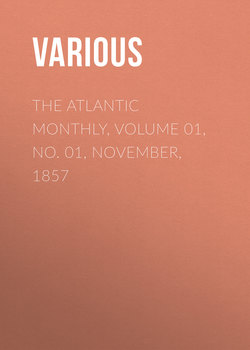Читать книгу The Atlantic Monthly, Volume 01, No. 01, November, 1857 - Various - Страница 3
FLORENTINE MOSAICS
II
SAN MINIATO
ОглавлениеThe walk to the church of San Miniato is a paved, steep path, through olive orchards fringed by a row of cypresses, to the little church of San Salvadore; thence, through a garden of roses and cabbages, fresh and fragrant in the December sun, to the convent of Miniato. From the terrace is one of the best views of the city; not so fine, however, as that from Bello Sguardo. The gentle, beautiful chain of hills which encircle Florence smile cheerfully in the sunshine, clapping their hands and skipping like lambs, if little hills ever did make such a demonstration. These environs of the town are like a frame of golden filigree, almost too fantastic a one for so shadowy and sombre a city. The green hill-sides and plains are sown thickly with palaces and villas glancing whitely through silvery forests of olives and myrtle; while the distant Apennines, like guardian giants, lift their icy shields in the distance.
The church is built upon the grave of the eminent saint, Miniato. This personage was, it seems, the son of the king of Armenia,—very much as all the heroes in the Arabian Nights are sons of the emperor of China. Having been converted to Christianity, he was offered by the emperor Decius great honors and rewards suitable to his royal rank, if he would renounce his faith. (A.D. 250.) He refused, and the emperor cut off his head. The execution took place in Florence, on the north side of the Arno. The holy man was not so easily disposed of, however; for he immediately clapped his head upon his shoulders again, and holding it on with both hands, waded across the river, and marched steadily up the hill on the other side. Arrived at the top, he gave up his head and the ghost. Hence the convent and church of San Miniato.
The church, to an architectural student, is interesting and important. A man needs a good eye and a good education to feel and thoroughly appreciate the grand symphonies which this wonderful architectural music of the Middle Ages has so long been silently playing. San Miniato belongs to the close of the Romanesque or Latin period. The early Christian school had expired in the midst of the general convulsions of the ninth and tenth centuries,—in the struggles of an effete and expiring antiquity with the brutal, blundering, but vigorous infancy of mediæval Europe. During the three centuries which succeeded, there was rather a warming into unnatural life of the mighty corpse, than the birth of a new organism, capable of healthy existence and unlimited reproduction. The Romanesque art seems to have dealt with the ancient forms, without moulding any thing essentially and vitally new. Where there seemed originality, it was, after all, only a theft from the Saracenic or Byzantine, and the plagiarism became incongruity when engrafted upon the Roman. Thus a Latin church was often but an early Christian basilica with a Moorish arcade.
The San Miniato has an arcade, of course not pointed, upon the façade and the interior. Its tessellated marble work, its ancient mosaics, with its Roman capitals and columns, all make it interesting. These last show that at the close of the epoch, even as at its beginning, the chain which binds the school to the ancient Roman is fastened anew.
The frescos in the sacristy, by Spinello Aretino, painted at the end of the fourteenth century, are singularly well preserved,—fresh as if painted yesterday. 'Tis a great pity that the works of other masters of the same age, Spinello's superiors, could not have been as fortunate. If the frescos of Orgagna, and of Benozzo Gozzoli in the Campo Santo at Pisa, were in as good condition, it would be much more satisfactory.
These pictures of Spinello are drawn with much boldness and energy, but it is not the fortunate audacity of Orgagna. They are much more the work of a mechanic, not self-distrustful, but with comparatively little feeling for the higher range of artistic expression. They are quite destitute of sentiment, but are not without a strong, rough, hardy humor. The drawing is far from accurate, but the coloring is well laid on. They represent the life and adventures of Saint Benedict, are of colossal size, and depict the saint in various striking positions. Here he is portrayed as rescuing a brother friar from the inconveniences resulting from a house having fallen upon him; in another he is miraculously mending a crockery jug belonging to his nurse; and in a third he is unsuccessfully attempting to move a large stone, upon which the Devil has seated himself, much to Benedict's discomfiture. The fiend is drawn, con amore, in black, with hairy hide, bat's wings, and a monkey's tail; the traditional Devil who has come down to us unharmed through all the vicissitudes of the Middle Ages. The saints and friars are generally attired in mazarine blue.
